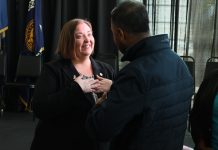
During the Obama years, no Michigan native wielded more behind-the-scenes influence in Washington than Cecilia MuĂąoz. First as director of intergovernmental affairs and then as historyâs longest-serving director of the White House Domestic Policy Council, the Detroit-born, Livonia-raised Latinx rights activist had a say in everything from the auto-industry bailout to immigration and much more. The DPC includes eight Cabinet secretaries, including energy, education, and transportation, so MuĂąoz sat at the intersection of pretty much every major issue.
More recently, MuĂąoz, 58, served on the Biden transition team before returning to her job as senior adviser to the D.C.-based, left-leaning nonprofit think tank New America. She says she did not want to return to the White House, and that may be just as well â a large swath of progressives got cranky on social media over her involvement with Biden because she is blamed for Obamaâs aggressive efforts to prevent illegal immigration.
MuĂąoz, the daughter of Bolivian immigrants and the third generation of her family to graduate from University of Michigan, talked to Ďă¸ŰÁůşĎ˛ĘÍźżâ×ĘÁĎ about those attacks, about the Biden response to a new surge of migration, and about how her Midwest roots guide her politics and activism.
Ďă¸ŰÁůşĎ˛ĘÍźżâ×ĘÁĎ: What about your upbringing in metro Detroit informed your worldview?
Cecilia MuĂąoz: My dad worked as an engineer for Ford for almost 40 years. Two things are true: One, my dad carried postcards in his pocket at work that were filled out to his congressmember and stamped, and he would hand them out to friends and colleagues to have them sign and mail. He was active and he got people around him active. I came from a family that discussed what my dad read in the Free PressĚý every day. But the other thing thatâs true is that that job at Ford made the American Dream real for my family. We lived in a comfortable house, all four of us went to college â the daughters as well as the sons, which did not happen a generation before me. We had health care, a roof over our heads, access to an excellent education. I always had a deep understanding that Detroit had made my familyâs life possible and that my job was to make the same things possible for everybody else.
How was life as a Latina here back then?Ěý
Iâve been in the D.C. area now for more than 30 years, but I still see myself as a Midwesterner. Iâm grateful that my ties to Michigan are still super strong. I spendĚýa lot of time in the Latinx community reminding people thereâs a Latinx community in the Midwest. Like Iâm a Midwestern Latina, and thatâs a thing, and Iâm really deeply proud of that.
We hear more about the Black experience around here.
Itâs funny, but after I joined the staff of the National Conference of La Raza in Washington in the 1990s and started to describe my civil rights work to my parents, they started to tell their stories. They were almost evicted from their first apartment in Detroit because the landlady caught them speaking Spanish and she accused them of speaking âMexican.â They never told us that when my aunt and uncle came to the States and ended up in Detroit, they came with five children and no one would rent them a house. They had to live in two apartments â he with the older kids and she with the younger kids.Ěý
Your presence in the Biden transition was controversial. People worried about you on account of your involvement in Obama-era immigration policies like family separations âŚ
We didnât actually separate families, but go ahead and ask your questions.
Wait, really? What about the photos of kids in cages from 2014?Ěý
Yeah. In 2014, we had an unexpected increase in the number of unaccompanied migrant children, which is the same thing thatâs happening now. Under the law, those children are to be moved from the Border Patrol facilities â which are lockups and not appropriate for kids â within 72 hours. Because it was an unexpected spike, we ran out of shelter space. The photos of kids from 2014 were from holding facilities we created. President Obama did the same thing President Biden is doing, which is bringing in FEMA to create facilities to get those kids out of Border Patrol lockups while the government set up additional shelter space. The point was to provide proper protection for kids. That became controversial only whenĚý Trump did something very different, which was taking children away from their parents.Ěý
What did you do with families, then?
Some got ankle bracelets and were released into the U.S. Some were in community monitoring, which is, essentially, where we piloted programs with some religious non-governmental organizations to release people into the community and the NGOs agreed to meet peopleâs needs and make sure they showed up at their asylum hearings. Some were detained, and we took great criticism for detaining families. But no, we didnât take peopleâs children.
Is it fair to say people are coming now because Trump is gone and thereâs a belief that itâs easier to get in?
No, itâs not. The last four years taught us a lot about whether how people are treated at the border affects decisions to migrate. Trump took away peopleâs infants. They took thousands of children away from their parents, thinking that when the word got out, people would stop coming. They didnât stop coming. Clearly something else drives migration. It has to do with the conditions in the countries that people are leaving. You canât fix what is actively a refugee crisis in our hemisphere at the border. You have to fix it where itâs happening. The Biden administration is taking steps to do that. It will take a while for them to be effective.
Surely that was the theory when Obama was in office, but it didnât work.
Actually, it did. There are three things which were starting to have an impact before they were dismantled by the Trump administration. The first was a program called the Central American Minors Program, which allowed kids who would otherwise be traveling alone or with smugglers to get refugee status and be brought to the United States to reunite with their families without having to cross Mexico alone. The second was a similar program for adults. And the third thing we did, and it was Vice President Biden who led this effort, was appropriate money to invest in partnerships in the countries where people come from to begin to address the reasons that they were migrating in the first place. It was starting to have impacts particularly in Honduras. None of that is a short-term fix, but a long-term fix requires an investment and work.
Was there any discussion of you joining the Biden administration?
No. I made it clear when I joined the transition that I was really, really happy to help get the Biden administration up to speed, but that I didnât intend to go into government. I did that. I was in the White House for eight years, which is a really long tour of duty. But Iâm pleased to say I helped draft a really awesome team thatâs doing great work here.
Any particular victories specifically for the Midwest or Michigan that come to mind from your Obama years?
Oh my gosh. Michigan has benefited enormously from the American Recovery Act, which passed in the first few weeks of the Obama administration. Obviously, the auto bailout, I was there for all of it. The potential for bankruptcies for major companies and the downstream effects that that would have had if the administration had allowed Chrysler to go under, for example â itâs hard to overstate how devastating it would have been. The auto bailout was incredibly controversial at the time. Now itâs widely understood as having saved the industry and the Midwest. The government got its money back with interest and the auto industry is now poised to take us into a clean energy future. Itâs impossible to overstate what a big deal that was for Michigan. Iâm proud of it. And I still drive a Ford.Ěý
|
| Ěý |
|








